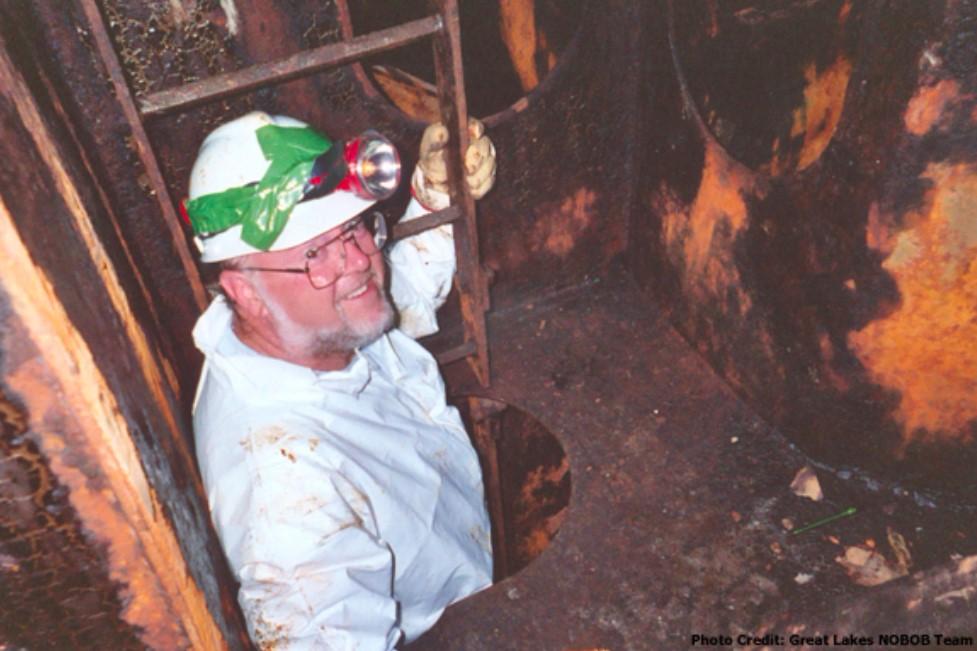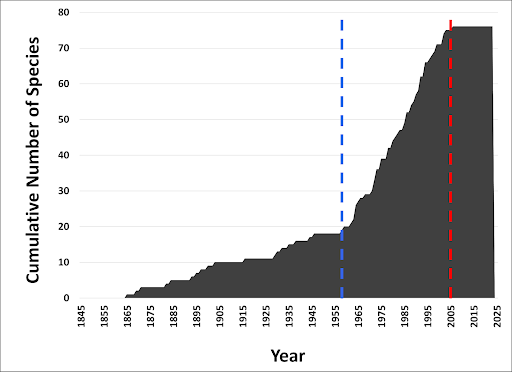Balancing act: A policy success story in the Great Lakes
Implementing the 'swish and spit' method successfully reduced the risk of AIS introductions from transoceanic ballast water.

The Great Lakes remain one of the most heavily invaded freshwater systems in the world. Ballast water from cargo ships crossing the ocean inadvertently brought in many aquatic invasive species (AIS), accounting for the introduction of 40% of all nonindigenous aquatic species in the Great Lakes. However, collaborative efforts have led to pioneering research and policy changes that have reduced this threat.
The problem with ballast water
In 1993 a team of scientists led by Ed Mills at Cornell University first made the connection between the growing rate of introductions of non-native species to the Great Lakes and ballast water. Ships carry ballast water to adjust buoyancy (i.e. the upward force that keeps objects afloat) and ensure they do not tilt to one side during their voyage. Loading and unloading cargo redistributes a ship's weight. Water is either discharged or taken on by pumping water into ballast tanks to rebalance the ship. This process is essential for a cargo ship’s stability, which improves handling in rough seas, maintains sailing speed and efficiency, and protects both ship and cargo. The exchange of ballast water usually occurs when ships are at port, but it can occur while in transit in open waters.
When ships pump in ballast water, they also take in aquatic organisms and sediments. Organisms trapped in ballast tanks can range from larger fish and aquatic plants to microscopic zooplankton and bacteria. When the ballast water is discharged, these trapped organisms are released as well. Since the Great Lakes is connected to a global shipping network, many non-native species have been introduced to the Great Lakes through this pathway.
While non-native species were introduced at a low rate to the Great Lakes basin prior to 1959, enlarging the St. Lawrence Seaway caused a rapid increase in AIS introductions from ballast water. The St. Lawrence Seaway facilitates the access of transoceanic ships and AIS to the Great Lakes and shipments through the Seaway are an important driver for the regional economy. The St. Lawrence shipping canals opened in 1847, and the technology for ballast water exchange was introduced in the 1880s. Then in 1959, the St. Lawrence Seaway was enlarged to allow more ships into the Great Lakes. The problem became so bad between 1980-2000, about 80% of new invaders introduced came from ballast water. Since 1959, 65% of new AIS introductions were from ballast water. Several of the most notable and impactful AIS entered the Great Lakes in ballast water discharge include zebra mussels (Dreissena polymorpha), quagga mussels (Dreissena rostriformis), and round gobies (Neogobius melanostomus). Despite its necessity for safe shipping practices, ballast water became a concern due to the environmental and economic hazard impacts caused by the invasive species it inadvertently carried into the region.
Working together to solve the problem
In an early effort to reduce AIS ballast water introductions, guidelines for ballast water exchange were first introduced by Canada in 1989, made voluntary in the U.S. in 1990 and later made mandatory by U.S. law in 1994. Transoceanic ships entering the Great Lakes from freshwater or brackish-water ports with “Ballast on Board” (BOB) had to exchange their ballast water while at sea or seal their tanks while in the Great Lakes. Freshwater organisms discharged into salty ocean water would be unable to survive there and any saltwater organisms taken up in the ocean would not be able to survive in freshwater in the Great Lakes. Despite high compliance by ships, AIS were still entering the Great Lakes at alarming rates.
In the early 2000’s, researchers turned their attention to “No Ballast on Board” (NOBOB) ships that had pumped all the ballast out (so as to carry maximum cargo) prior to crossing the ocean. These NOBOB ships accounted for over 80% of ships entering the Great Lakes, but were exempt from ocean ballast water exchange requirements at the time because they were assumed to be empty of ballast. Dr. David Reid, a physical scientist at the Great Lakes Environmental Research Laboratory (GLERL) in Ann Arbor, Michigan, helped spearhead research on NOBOB ships. Dr. Reid's initial work building a shipping database helped reveal links between NOBOB ships and AIS introductions. Dr. Reid then put together and secured funding for a team of researchers from NOAA and several universities in collaboration with industry partners. Dr. Reid’s research team demonstrated that the ‘empty’ ballast tanks of NOBOB ships still carried residual ballast water and sediments. This residual was typically much less than 1% of the total ballast volume, but became concentrated with sediments that settled in the bottom of the tanks as water was pumped in and out. Furthermore, the researchers demonstrated that microorganisms, and invertebrates with dormant stages could survive in the residual ballast water and sediments. When these ships arrived at their first Great Lakes port of call and started off loading cargo, they took on fresh ballast water which mixed with the residuals in the NOBOB tank, which would then be pumped out into the Great Lakes when the ship took on new cargo before making its return voyage. AIS living in the residual ballast of NOBOB vessels was still being discharged into the Great Lakes.

In addition to his scholarly contributions, Dr. Reid played a pivotal role in policy development related to ballast water management. His collaborative efforts with government agencies, research institutions, and industry stakeholders aided the development of regulatory frameworks aimed at reducing the risks associated with NOBOB ships. By engaging with policymakers, Dr. Reid helped shape the trajectory of environmental policy and sustainable shipping practices in the Great Lakes. Dr. Reid also envisioned and established the NOAA-led Great Lakes Aquatic Nonindigenous Species Information System (GLANSIS) which continues to track non-native species in the Great Lakes today, gathering evidence needed to measure the impact of Great Lakes invasive species and evaluate the success of AIS management strategies in the region.
In direct response to this research, Canada (2006), and the United States (2008), implemented stricter rules requiring ships entering the Great Lakes to rinse their ballast tanks with saltwater to remove and kill potential AIS. This method of ballast water exchange was nicknamed the “swish and spit.” All transoceanic ships were required to rinse tanks with saltwater at sea or equivalent salinity conditions (>30 ppt), which is outside the salt tolerance of most freshwater aquatic species. These regulations have been enforced by checking ships' records and examining water salinity, with the majority of ships complying. Non-compliant ships can also be denied entry to the Great Lakes, and required to turn around and go back to an area with salt water to complete the exchange. This management regulation for the Great Lakes St. Lawrence Seaway System continues to be one of the most stringent in the world.
A success story
Implementing the “swish and spit” method successfully reduced the risk of AIS introductions from transoceanic ballast water. Since 2006, there have been no confirmed introductions of AIS to the Great Lakes through ballast water exchange (Figure 1). There are no other regulations that are linked to such a significant reduction in AIS invasion rates. This rare success story is an example of what can happen when scientists, policy makers, regulators, and industries work together to find solutions. NOAA GLERL and partners recognized Dr. Reid for his contributions in September 2023.

On-going research
Researchers continue to explore and introduce improved methods for treating ballast water, such as filtration, chemical, heat, and ultraviolet treatments. The successful prevention of new AIS from transoceanic ships has also allowed researchers and policy makers to turn their attention to freighter ships that sail exclusively in the Great Lakes (commonly referred to as ‘lakers’). Ballast water from lakers remains largely unregulated, despite evidence that lakers help spread invaders within the Great Lakes basin. Environmentalists have called for new regulations and standards for lakers given the success of ballast regulations on transoceanic ships. The implementation of such regulations faces logistical hurdles and significant costs, highlighting the need for further research and policy measures to safeguard the economic and ecological resources of the Great Lakes.
How you can help
Despite effective management on ballast water, the majority of AIS introductions in the Great Lakes still occur through other pathways as discussed in the companion article “The Less Traveled Pathways for Species Introduction to the Great Lakes.” Species introduced by ballast decades ago are also still spreading within the Great Lakes. There are several things the general public in Michigan can do to help prevent the introduction and stop the spread of invasive species:
- Clean, drain, and dry recreational boats after every usage. Much like ballast tanks on cargo ships, AIS can hitchhike on personal water crafts.
- Practice responsible pet ownership and never release unwanted pets or the contents of aquariums into the wild.
- Help biologists monitor and detect the spread of AIS through community science efforts. The public is strongly encouraged to report any invasive species sightings. The location and date of sightings, along with photos for species identification, can be recorded in the USGS Nonindigenous Aquatic Species Sighting Report Form.
- Learn more about AIS at the Great Lakes Aquatic Nonindigenous Species Information System.
Additional resources
- Ballast Water: GLANSIS Series Part 2 - Watch this video on ballast water as part of the GLANSIS "Managing Great Lakes Invaders" YouTube series.
- NOAA GLERL Blog - Read about NOAA GLERL recognizing Dr. David Reid for his career achievements.
- EGLE FAQ: Ballast Water - Go over some common ballast water questions on the Michigan Department of Environment, Great Lakes, and Energy website.
- Stop Aquatic Hitchhikers - Learn how to stop the spread of aquatic invasive species on personal water crafts.
- Don’t Let it Loose - Look into this nationwide campaign supported by the U.S. Fish and Wildlife to help rehome unwanted pets.
- Reduce Invasive Pet and Plant Escapes (RIPPLE) - Education initiatives coordinated by Michigan State University Extension, the program offers information to aquarium and water gardener professionals, retailers and hobbyists about what to do with unwanted plants and animals.
Michigan Sea Grant helps to foster economic growth and protect Michigan’s coastal, Great Lakes resources through education, research and outreach. A collaborative effort of the University of Michigan and Michigan State University and its MSU Extension, Michigan Sea Grant is part of the NOAA-National Sea Grant network of 34 university-based programs.
This article was prepared by Michigan Sea Grant under award NA22OAR4170084 from the National Oceanic and Atmospheric Administration, U.S. Department of Commerce through the Regents of the University of Michigan. The statement, findings, conclusions, and recommendations are those of the author(s) and do not necessarily reflect the views of the National Oceanic and Atmospheric Administration, the Department of Commerce, or the Regents of the University of Michigan.



 Print
Print Email
Email
